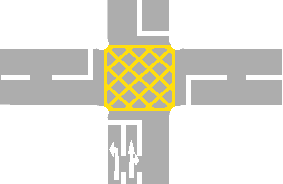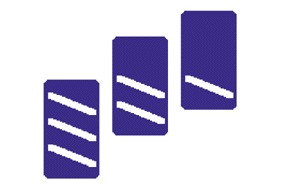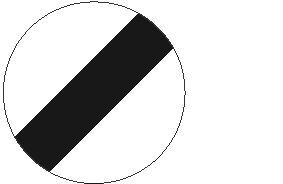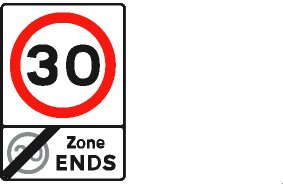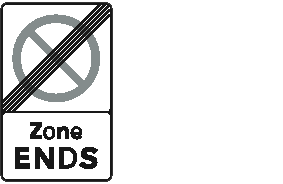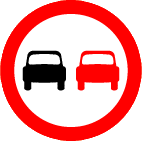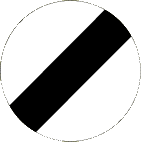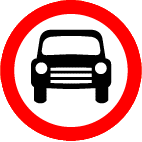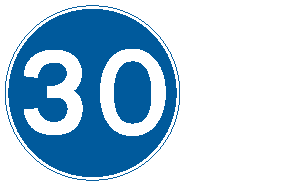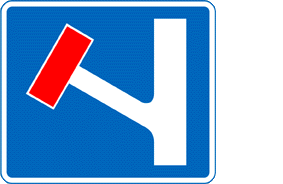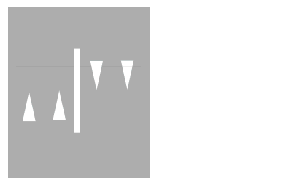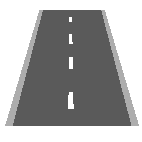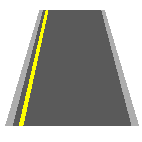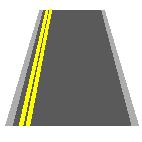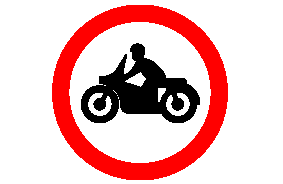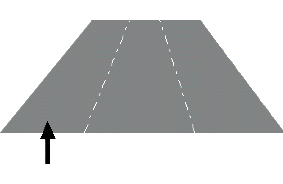This mock driving theory test consists of 50 official questions.
You need 43 out of 50 (86%) to pass. You have a time limit of 57 minutes.
Read more about the theory test and how it works.
There are no tests related to this category :
There are no tests related to this category :
Quick view of test questions. Click question box to reveal correct answer.
Correct Answer: C
Explanation: The purpose of a box junction is to keep the junction clear by preventing vehicles from stopping in the path of crossing traffic. You mustn't enter a box junction unless your exit is clear. However, you may enter the box and wait if you want to turn right and are only prevented from doing so by oncoming traffic.
Explanation: The purpose of a box junction is to keep the junction clear by preventing vehicles from stopping in the path of crossing traffic. You mustn't enter a box junction unless your exit is clear. However, you may enter the box and wait if you want to turn right and are only prevented from doing so by oncoming traffic.
Correct Answer: C
Explanation: The exit from a motorway is indicated by countdown markers. These are positioned 90 metres (100 yards) apart, the first being 270 metres (300 yards) from the start of the slip road. Move into the left-hand lane well before you reach the start of the slip road.
Explanation: The exit from a motorway is indicated by countdown markers. These are positioned 90 metres (100 yards) apart, the first being 270 metres (300 yards) from the start of the slip road. Move into the left-hand lane well before you reach the start of the slip road.
Correct Answer: B
Explanation: The studs between the carriageway and the hard shoulder are normally red. These change to green where there's a slip road, helping you to identify slip roads when visibility is poor or when it's dark.
Explanation: The studs between the carriageway and the hard shoulder are normally red. These change to green where there's a slip road, helping you to identify slip roads when visibility is poor or when it's dark.
Correct Answer: B
Explanation: This sign doesn't tell you the speed limit in figures. You should know the speed limit for the type of road that you're on and the type of vehicle that you're driving. Study your copy of The Highway Code.
Explanation: This sign doesn't tell you the speed limit in figures. You should know the speed limit for the type of road that you're on and the type of vehicle that you're driving. Study your copy of The Highway Code.
5. There's a tractor ahead. You want to overtake but you aren't sure whether it's safe. What should you do?
Mark one answer
AB
C
D
Correct Answer: D
Explanation: Following a tractor can be frustrating, but never overtake if you're unsure whether it's safe. Ask yourself: 'Can I see far enough down the road to ensure that I can complete the manoeuvre safely?' It's better to be delayed for a minute or two than to take a chance that may cause a collision.
Explanation: Following a tractor can be frustrating, but never overtake if you're unsure whether it's safe. Ask yourself: 'Can I see far enough down the road to ensure that I can complete the manoeuvre safely?' It's better to be delayed for a minute or two than to take a chance that may cause a collision.
Correct Answer: C
Explanation: Long vehicles might have to take a slightly different position when approaching the roundabout or going around it. This is to stop the rear of the vehicle cutting in and mounting the kerb.
Explanation: Long vehicles might have to take a slightly different position when approaching the roundabout or going around it. This is to stop the rear of the vehicle cutting in and mounting the kerb.
Correct Answer: A
Explanation: Where you see this sign, the 20 mph restriction ends. Check all around for possible hazards and only increase your speed if it's safe to do so.
Explanation: Where you see this sign, the 20 mph restriction ends. Check all around for possible hazards and only increase your speed if it's safe to do so.
Correct Answer: C
Explanation: Even though you've left the restricted area, make sure that you park where you won't endanger other road users or cause an obstruction.
Explanation: Even though you've left the restricted area, make sure that you park where you won't endanger other road users or cause an obstruction.
Correct Answer: B
Explanation: Stopping where this clearway restriction applies is likely to cause congestion. Allow the traffic to flow by obeying the signs.
Explanation: Stopping where this clearway restriction applies is likely to cause congestion. Allow the traffic to flow by obeying the signs.
Correct Answer: C
Explanation: This sign is shown where slow-moving vehicles would impede the flow of traffic; for example, in tunnels. However, if you need to slow down or even stop to avoid an incident or potential collision, you should do so.
Explanation: This sign is shown where slow-moving vehicles would impede the flow of traffic; for example, in tunnels. However, if you need to slow down or even stop to avoid an incident or potential collision, you should do so.
Correct Answer: B
Explanation: This sign shows you that you can't get through to another route by turning left at the junction ahead.
Explanation: This sign shows you that you can't get through to another route by turning left at the junction ahead.
Correct Answer: A
Explanation: When traffic lights are out of order, you should treat the junction as an unmarked crossroads. Be cautious, as you may need to give way or stop. Look for traffic attempting to cross the junction, unaware that it doesn't have priority.
Explanation: When traffic lights are out of order, you should treat the junction as an unmarked crossroads. Be cautious, as you may need to give way or stop. Look for traffic attempting to cross the junction, unaware that it doesn't have priority.
Correct Answer: D
Explanation: Because the road has a dark colour, changes in level aren't easily seen. White triangles painted on the road surface give you an indication of where there are road humps.
Explanation: Because the road has a dark colour, changes in level aren't easily seen. White triangles painted on the road surface give you an indication of where there are road humps.
Correct Answer: A
Explanation: You need to know the difference between the normal centre line and a hazard warning line. If there's a hazard ahead, the markings are longer and the gaps shorter. This gives you advance warning of an unspecified hazard.
Explanation: You need to know the difference between the normal centre line and a hazard warning line. If there's a hazard ahead, the markings are longer and the gaps shorter. This gives you advance warning of an unspecified hazard.
15. You see this line across the road at the entrance to a roundabout. What does it mean?
Mark one answer

B
C
D
Correct Answer: A
Explanation: Slow down as you approach the roundabout and check for traffic from the right. If you need to stop and give way, stay behind the broken line until it's safe to emerge onto the roundabout.
Explanation: Slow down as you approach the roundabout and check for traffic from the right. If you need to stop and give way, stay behind the broken line until it's safe to emerge onto the roundabout.
16. You're towing a small trailer on a busy three-lane motorway. What must you do if all the lanes are open?
Mark one answer
AB
C
D
Correct Answer: D
Explanation: The motorway regulations for towing a trailer state that you mustn't
use the right-hand lane of a three-lane motorway unless directed to do so (for example, at roadworks or due to a lane closure)
exceed 60 mph
Explanation: The motorway regulations for towing a trailer state that you mustn't
use the right-hand lane of a three-lane motorway unless directed to do so (for example, at roadworks or due to a lane closure)
exceed 60 mph
17. As you approach a pelican crossing, the lights change to green. What should you do if elderly people are halfway across?
Mark one answer
AB
C
D
Correct Answer: C
Explanation: If the lights turn to green, wait for any pedestrians to clear the crossing. Allow them to finish crossing the road in their own time, and don't try to hurry them by revving your engine.
Explanation: If the lights turn to green, wait for any pedestrians to clear the crossing. Allow them to finish crossing the road in their own time, and don't try to hurry them by revving your engine.
18. What should you do when you're approaching traffic lights that have been on green for some time?
Mark one answer
AB
C
D
Correct Answer: B
Explanation: The longer traffic lights have been on green, the sooner they'll change. Allow for this as you approach traffic lights that you know have been on green for a while. They're likely to change soon, so you should be prepared to stop.
Explanation: The longer traffic lights have been on green, the sooner they'll change. Allow for this as you approach traffic lights that you know have been on green for a while. They're likely to change soon, so you should be prepared to stop.
Correct Answer: A
Explanation: The markings are there to show that the area must be kept clear. This is to allow an unrestricted view for
- approaching drivers and riders
- children wanting to cross the road
Explanation: The markings are there to show that the area must be kept clear. This is to allow an unrestricted view for
- approaching drivers and riders
- children wanting to cross the road
Correct Answer: A
Explanation: Traffic is passing you at speed. If the draught from a large lorry catches you by surprise, it could blow you off balance and even onto the carriageway. By facing the oncoming traffic, you can see approaching lorries and so be prepared for their draught. You'll also be in a position to see other hazards approaching.
Explanation: Traffic is passing you at speed. If the draught from a large lorry catches you by surprise, it could blow you off balance and even onto the carriageway. By facing the oncoming traffic, you can see approaching lorries and so be prepared for their draught. You'll also be in a position to see other hazards approaching.
Correct Answer: D
Explanation: You must comply with all traffic signs and be especially aware of those signs that apply specifically to the type of vehicle you're using.
Explanation: You must comply with all traffic signs and be especially aware of those signs that apply specifically to the type of vehicle you're using.
Correct Answer: B
Explanation: To prevent your lights from dazzling the driver of the car in front, wait until you've passed them before switching to full beam.
Explanation: To prevent your lights from dazzling the driver of the car in front, wait until you've passed them before switching to full beam.
Correct Answer: C
Explanation: Engines that burn fossil fuels produce exhaust emissions that are harmful to health. The harder you make the engine work, the more emissions it will produce. Engines also use more fuel and produce higher levels of emissions when they're cold. Anything you can do to reduce your use of fossil fuels will help the environment.
Explanation: Engines that burn fossil fuels produce exhaust emissions that are harmful to health. The harder you make the engine work, the more emissions it will produce. Engines also use more fuel and produce higher levels of emissions when they're cold. Anything you can do to reduce your use of fossil fuels will help the environment.
Correct Answer: A
Explanation: The names of towns and cities may be painted on the road at busy junctions and complex road systems. Their purpose is to let you move into the correct lane in good time, allowing traffic to flow more freely.
Explanation: The names of towns and cities may be painted on the road at busy junctions and complex road systems. Their purpose is to let you move into the correct lane in good time, allowing traffic to flow more freely.
Correct Answer: A
Explanation: Trams may run on roads used by other vehicles and pedestrians. The section of road used by trams is known as the reserved area and should be kept clear. It usually has a different surface, edged with white lane markings.
Explanation: Trams may run on roads used by other vehicles and pedestrians. The section of road used by trams is known as the reserved area and should be kept clear. It usually has a different surface, edged with white lane markings.
Correct Answer: C
Explanation: A SORN allows you to keep a vehicle off-road and untaxed. SORN will end when the vehicle is taxed, sold or scrapped.
Explanation: A SORN allows you to keep a vehicle off-road and untaxed. SORN will end when the vehicle is taxed, sold or scrapped.
27. What's the national speed limit on a single carriageway road for cars and motorcycles?
Mark one answer
AB
C
D
Correct Answer: C
Explanation: Exceeding the speed limit is dangerous and can result in you receiving penalty points on your licence. It isn't worth it. You should know the speed limit for the road that you're on by observing the road signs. Different speed limits apply if you're towing a trailer.
Explanation: Exceeding the speed limit is dangerous and can result in you receiving penalty points on your licence. It isn't worth it. You should know the speed limit for the road that you're on by observing the road signs. Different speed limits apply if you're towing a trailer.
Correct Answer: A
Explanation: Using a vehicle on the road illegally carries a heavy fine and can lead to penalty points on your driving licence. You must have
- a valid driving licence
- paid the appropriate vehicle excise duty (road tax)
- proper insurance cover
Explanation: Using a vehicle on the road illegally carries a heavy fine and can lead to penalty points on your driving licence. You must have
- a valid driving licence
- paid the appropriate vehicle excise duty (road tax)
- proper insurance cover
29. You're travelling at 50 mph on a good, dry road. What's your typical overall stopping distance?
Mark one answer
AB
C
D
Correct Answer: B
Explanation: Even in good conditions, it will usually take you further than you think to stop. Don't just learn the figures; make sure you understand how far the distance is.
Explanation: Even in good conditions, it will usually take you further than you think to stop. Don't just learn the figures; make sure you understand how far the distance is.
Correct Answer: D
Explanation: In strong winds, riders of two-wheeled vehicles are particularly vulnerable. When you overtake them, allow plenty of room. Always check to the left as you pass.
Explanation: In strong winds, riders of two-wheeled vehicles are particularly vulnerable. When you overtake them, allow plenty of room. Always check to the left as you pass.
A
B
C
D
B
C
D
Correct Answer: D
Explanation: An adult casualty isn't breathing normally. To maintain circulation, place two hands on the centre of the chest. Then press down hard and fast - around 5-6 centimetres and about twice a second.
Explanation: An adult casualty isn't breathing normally. To maintain circulation, place two hands on the centre of the chest. Then press down hard and fast - around 5-6 centimetres and about twice a second.
Correct Answer: A
Explanation: In a contraflow system, you'll be travelling close to oncoming traffic and sometimes in narrow lanes. You should get into the correct lane in good time, obey any temporary speed-limit signs and keep a safe separation distance from the vehicle ahead.
Explanation: In a contraflow system, you'll be travelling close to oncoming traffic and sometimes in narrow lanes. You should get into the correct lane in good time, obey any temporary speed-limit signs and keep a safe separation distance from the vehicle ahead.
33. It's very windy. You're behind a motorcyclist who's overtaking a high-sided vehicle. What should you do?
Mark one answer
AB
C
D
Correct Answer: B
Explanation: Windy weather affects motorcyclists more than other vehicles. In windy conditions, high-sided vehicles cause air turbulence. You should keep well back, as the motorcyclist could be blown off course.
Explanation: Windy weather affects motorcyclists more than other vehicles. In windy conditions, high-sided vehicles cause air turbulence. You should keep well back, as the motorcyclist could be blown off course.
Correct Answer: B
Explanation: The engine will need more power to pull the vehicle up the hill. When approaching a steep hill you should select a lower gear to help maintain your speed. You should do this without hesitation, so that you don't lose too much speed before engaging the lower gear.
Explanation: The engine will need more power to pull the vehicle up the hill. When approaching a steep hill you should select a lower gear to help maintain your speed. You should do this without hesitation, so that you don't lose too much speed before engaging the lower gear.
A
B
C
D
B
C
D
Correct Answer: B
Explanation: If you're following another road user in fog, stay well back. The driver in front won't be able to see hazards until they're close and might need to brake suddenly. Also, the road surface is likely to be wet and could be slippery.
Explanation: If you're following another road user in fog, stay well back. The driver in front won't be able to see hazards until they're close and might need to brake suddenly. Also, the road surface is likely to be wet and could be slippery.
Correct Answer: B
Explanation: You should drive in the left-hand lane whenever possible. Only use the other lanes for overtaking or when directed to do so by signals. Using other lanes when the left-hand lane is empty can frustrate drivers behind you.
Explanation: You should drive in the left-hand lane whenever possible. Only use the other lanes for overtaking or when directed to do so by signals. Using other lanes when the left-hand lane is empty can frustrate drivers behind you.
37. You've broken down on a two-way road. You have a warning triangle. At least how far from your vehicle should you place the warning triangle?
Mark one answer
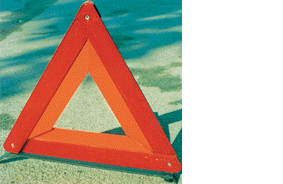
B
C
D
Correct Answer: C
Explanation: Advance warning triangles fold flat and don't take up much room. Use one to warn other road users if your vehicle has broken down or if there has been an incident. Place it at least 45 metres (147 feet) behind your vehicle (or the incident), on the same side of the road or verge. Place it further back if the scene is hidden by, for example, a bend, hill or dip in the road. Don't use warning triangles on motorways.
Explanation: Advance warning triangles fold flat and don't take up much room. Use one to warn other road users if your vehicle has broken down or if there has been an incident. Place it at least 45 metres (147 feet) behind your vehicle (or the incident), on the same side of the road or verge. Place it further back if the scene is hidden by, for example, a bend, hill or dip in the road. Don't use warning triangles on motorways.
38. You take some cough medicine given to you by a friend. What should you do before driving?
Mark one answer
AB
C
D
Correct Answer: B
Explanation: If you've taken medicine, never drive without first checking what the side effects might be; they might affect your judgement and perception, and therefore endanger lives.
Explanation: If you've taken medicine, never drive without first checking what the side effects might be; they might affect your judgement and perception, and therefore endanger lives.
Correct Answer: B
Explanation: Don't forget to switch off your fog lights when the weather improves. You could be prosecuted for driving with them on in good visibility. The high intensity of rear fog lights can dazzle following drivers and make your brake lights difficult to notice.
Explanation: Don't forget to switch off your fog lights when the weather improves. You could be prosecuted for driving with them on in good visibility. The high intensity of rear fog lights can dazzle following drivers and make your brake lights difficult to notice.
40. You're approaching a zebra crossing. Pedestrians are waiting to cross. What should you do?
Mark one answer
AB
C
D
Correct Answer: B
Explanation: As you approach a zebra crossing, look for pedestrians waiting to cross. Where you can see them, slow down and prepare to stop. Be especially careful of children and older people, who may have difficulty judging when it's safe to cross.
Explanation: As you approach a zebra crossing, look for pedestrians waiting to cross. Where you can see them, slow down and prepare to stop. Be especially careful of children and older people, who may have difficulty judging when it's safe to cross.
Correct Answer: A
Explanation: Carrying heavy loads will affect control and the vehicle's handling characteristics. If the vehicle you're driving is overloaded, you'll be held responsible.
Explanation: Carrying heavy loads will affect control and the vehicle's handling characteristics. If the vehicle you're driving is overloaded, you'll be held responsible.
Correct Answer: B
Explanation: Windscreen pillars can obstruct your view, particularly at bends and junctions. Look out for other road users - especially cyclists, motorcyclists and pedestrians - as they can easily be hidden by this obstruction.
Explanation: Windscreen pillars can obstruct your view, particularly at bends and junctions. Look out for other road users - especially cyclists, motorcyclists and pedestrians - as they can easily be hidden by this obstruction.
Correct Answer: D
Explanation: Leaving your indicators on could confuse other road users and may even lead to a crash. Be aware that if you haven't taken a sharp turn, your indicators may not self-cancel and you'll need to turn them off manually.
Explanation: Leaving your indicators on could confuse other road users and may even lead to a crash. Be aware that if you haven't taken a sharp turn, your indicators may not self-cancel and you'll need to turn them off manually.
A
B
C
D
B
C
D
Correct Answer: D
Explanation: This is more likely to happen on vehicles fitted with drum brakes, but it can apply to disc brakes as well. Using a lower gear will assist the braking and help you to keep control of your vehicle.
Explanation: This is more likely to happen on vehicles fitted with drum brakes, but it can apply to disc brakes as well. Using a lower gear will assist the braking and help you to keep control of your vehicle.
Correct Answer: D
Explanation: Modern vehicles provide the driver with well-positioned mirrors, which are essential to safe driving. However, they can't see every angle of the scene behind and to the sides of the vehicle. This is why it's essential that, when necessary, you look around to check those areas not visible in your mirrors.
Explanation: Modern vehicles provide the driver with well-positioned mirrors, which are essential to safe driving. However, they can't see every angle of the scene behind and to the sides of the vehicle. This is why it's essential that, when necessary, you look around to check those areas not visible in your mirrors.
Correct Answer: D
Explanation: When driving a motor car, a learner driver who holds a provisional driving licence must
- display red L plates (or D plates in Wales) to the front and rear of the vehicle
- be insured to drive the vehicle
- be accompanied by someone who's at least 21 years old and who has held for at least three years (and still holds) a full licence for the category of vehicle being driven.
Explanation: When driving a motor car, a learner driver who holds a provisional driving licence must
- display red L plates (or D plates in Wales) to the front and rear of the vehicle
- be insured to drive the vehicle
- be accompanied by someone who's at least 21 years old and who has held for at least three years (and still holds) a full licence for the category of vehicle being driven.
47. You're driving down a steep hill. Why could it be dangerous to keep the clutch down or roll in neutral for too long?
Mark one answer
AB
C
D
Correct Answer: D
Explanation: Driving in neutral or with the clutch down for long periods is known as 'coasting'. There will be no engine braking and your vehicle will pick up speed on downhill slopes. Coasting can be very dangerous because it reduces steering and braking control.
Explanation: Driving in neutral or with the clutch down for long periods is known as 'coasting'. There will be no engine braking and your vehicle will pick up speed on downhill slopes. Coasting can be very dangerous because it reduces steering and braking control.
Correct Answer: B
Explanation: Ecosafe driving is all about becoming a more environmentally friendly driver. This will make your journeys more comfortable, as well as considerably reducing your fuel bills and reducing emissions that can damage the environment.
Explanation: Ecosafe driving is all about becoming a more environmentally friendly driver. This will make your journeys more comfortable, as well as considerably reducing your fuel bills and reducing emissions that can damage the environment.
A
B
C
D
B
C
D
Correct Answer: C
Explanation: Passengers should always be secured and safe. Children should be encouraged to fasten their seat belts or approved restraints themselves from an early age, so that it becomes a matter of routine. As the driver, you must check that they're fastened securely. It's your responsibility.
Explanation: Passengers should always be secured and safe. Children should be encouraged to fasten their seat belts or approved restraints themselves from an early age, so that it becomes a matter of routine. As the driver, you must check that they're fastened securely. It's your responsibility.
Correct Answer: D
Explanation: You must stop your vehicle when signalled to do so by a
- police or traffic officer
- traffic warden
- school crossing patrol
- red traffic light.
You must also stop if you're involved in an incident which causes damage or injury to any other person, vehicle, animal or property.
Explanation: You must stop your vehicle when signalled to do so by a
- police or traffic officer
- traffic warden
- school crossing patrol
- red traffic light.
You must also stop if you're involved in an incident which causes damage or injury to any other person, vehicle, animal or property.


